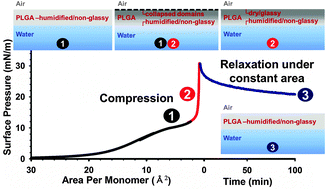Humidity-dependent compression-induced glass transition of the air–water interfacial Langmuir films of poly(d,l-lactic acid-ran-glycolic acid) (PLGA)†
Abstract
Constant rate compression isotherms of the air–water interfacial Langmuir films of poly(D,L-lactic acid-ran-glycolic acid) (PLGA) show a distinct feature of an exponential increase in surface pressure in the high surface polymer concentration regime. We have previously demonstrated that this abrupt increase in surface pressure is linked to the glass transition of the polymer film, but the detailed mechanism of this process is not fully understood. In order to obtain a molecular-level understanding of this behavior, we performed extensive characterizations of the surface mechanical, structural and rheological properties of Langmuir PLGA films at the air–water interface, using combined experimental techniques including the Langmuir film balance, X-ray reflectivity and double-wall-ring interfacial rheometry methods. We observed that the mechanical and structural responses of the Langmuir PLGA films are significantly dependent on the rate of film compression; the glass transition was induced in the PLGA film only at fast compression rates. Surprisingly, we found that this deformation rate dependence is also dependent on the humidity of the environment. With water acting as a plasticizer for the PLGA material, the diffusion of water molecules through the PLGA film seems to be the key factor in the determination of the glass transformation properties and thus the mechanical response of the PLGA film against lateral compression. Based on our combined results, we hypothesize the following mechanism for the compression-induced glass transformation of the Langmuir PLGA film; (1) initially, a humidified/non-glassy PLGA film is formed in the full surface-coverage region (where the surface pressure shows a plateau) during compression; (2) further compression leads to the collapse of the PLGA chains and the formation of new surfaces on the air side of the film, and this newly formed top layer of the PLGA film is transiently glassy in character because the water evaporation rate in the top surface region is momentarily faster than the humidification rate (due to the initial roughness of the newly formed surface); (3) after some time, the top layer itself becomes humidified through diffusion of water from the subphase, and thus it becomes non-glassy, leading to the relaxation of the applied compressive stress.


 Please wait while we load your content...
Please wait while we load your content...